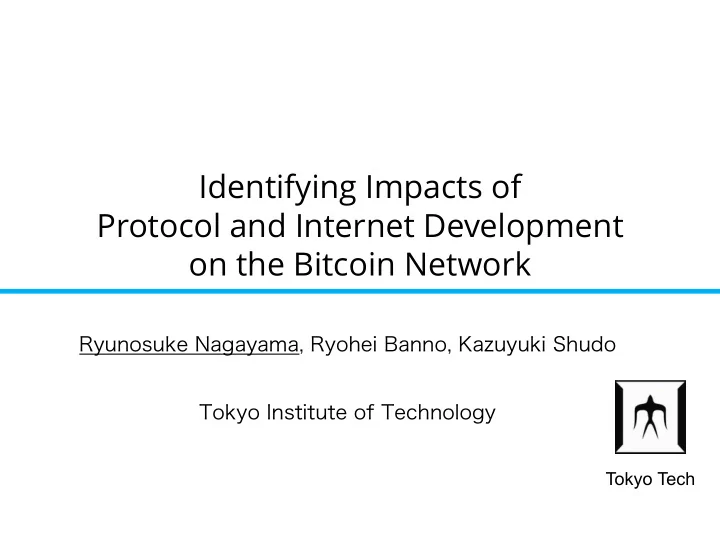

Tokyo Institute of Technology Identifying Impacts of Protocol and Internet Development on the Bitcoin Network Ryunosuke Nagayama, Ryohei Banno, Kazuyuki Shudo Tokyo Tech
Blockchain • A distributed ledger on P2P network • A node generates a "block" including transactions and a hash value of its parent block. Node Blockchain Block hash hash hash nonce nonce nonce Tx Tx Tx Tx Tx Tx Tx Tx Tx 1/18
Transaction approval Transaction throughput Bitcoin: 7 tx/s Larger block size # 𝑝𝑔 𝑢𝑠𝑏𝑜𝑡𝑏𝑑𝑢𝑗𝑝𝑜𝑡 𝑗𝑜 𝑏 𝑐𝑚𝑝𝑑𝑙 𝐶𝑚𝑝𝑑𝑙 𝑓𝑜𝑓𝑠𝑏𝑢𝑗𝑝𝑜 𝑗𝑜𝑢𝑓𝑠𝑤𝑏𝑚 Shorter interval Confirmation time Bitcoin: 10 min × 6 blocks = 1 hour To make overwriting difficult, transactions should be buried under a sufficient number of blocks. Shorter interval Less number of blocks until confirmation 2/18
Fork The shorter generation interval and larger block size, the more difficult it becomes to share blocks with other nodes. If not shared enough, the blockchain will fork and be inconsistent in the network. Reduce block propagation delay. 3/18
History of block propagation delay on Bitcoin network Block propagation delay has been reduced 50th percentile : 8.0 s → 0.4 s 90th percentile :16.7 s → 2.3 s “Bitcoin Network Monitor - DSN Research Group, KASTEL @ KIT,” 4/18 https://dsn.tm.kit.edu/bitcoin/
Why has the propagation delay been reduced? Relay server • Relay network Relay servers propagate blocks efficiently to participating nodes. [Otsuki, 2019] • Development of the Bitcoin protocol • Compact block relay (CBR) • Improvements of the Internet • network latency between peers • bandwidth 5/18
Why was the propagation delay reduced? Relay server • Relay network Relay servers propagate blocks efficiently to participating nodes. [Otsuki, 2019] We evaluate following two factors quantitatively and individually by simulation. • Development of the Bitcoin protocol • Compact block relay (CBR) • Improvements of the Internet • network latency between peers • bandwidth 6/18
Experiment [Aoki, 2019] A blockchain network simulator that simulates block propagation between nodes. It implements • Compact Block Relay is implemented. • Internet parameters as of 2015 and 2019 are implemented. • Node distribution Number of nodes in each country is obtained from Bitnodes. • Network latency Weighted average of latency between countries by number of nodes • Bandwidth Weighted average of bandwidth in countries by number of nodes 7/18
Compact Block Relay (CBR) CBR reduces propagation data size by containing only transaction IDs. If a node does not have transactions approved by a received block (block reconstruct fails), the node request them to its peer. Legacy CBR hash hash Tx2 Tx 1 Tx 2 Tx1 nonce nonce ID1 ID2 ID3 Tx1 Tx3 Tx2 GetBlockTx(ID3) Tx 3 ID3 8/18
CBR protocol mode In high bandwidth relaying, nodes send compact block before block validation, and do not send inv message. It wastes bandwidth. → We assume nodes use low bandwidth relaying. Low Bandwidth High Bandwidth Relaying Relaying 9/18
Modeling block reconstruct failure Our approximate model Actual CBR hash hash Tx 1 nonce nonce A node fails reconstruct ID1 ID3 ID1 ID3 ID2 ID2 based on failure rate. GetBlockTx GetBlockTx (ID2,ID3) x is obtain from x MB the failure size Tx 2 ID2 distribution. Tx 3 ID3 10/18
CBR Parameters • Compact block size 18 KB [Ozisik 2016] • CBR usage rate 96.4 % • The usage rate is based on the versions of protocol used by each nodes obtained from Bitnodes. • Reconstruction failure rate • Imtiaz et. al [Imtiaz 2019] measured • Churn node 27 % • Control node (Stay connected to the network) 13 % • Ratio of churn nodes 97.6% • Imtiaz et. al [Imtiaz 2019] measured [Ozisik 2016] A. P. Ozisik et. al, "A secure efficient and transparent network architecture for Bitcoin", 2016. [Imtiaz 2019]Muhammad Anas Imtiaz et. al, Churn in the Bitcoin Network: Characterization and Impact, IEEE International Conference on Blockchain and Cryptocurrency, 2019 11/18
Data size received from peer when reconstruction fails The data size is obtained from the cumulative distribution that approximates the data measured by Imtiaz et. al [Imtiaz 2019] . [Imtiaz 2019] Muhammad Anas Imtiaz et. al, Churn in the Bitcoin Network: Characterization and Impact, IEEE International Conference on Blockchain and Cryptocurrency, 2019 12/18
Comparison with measured data Measured [2] Our simulation 2015 7,988 ms 9,673 ms 50%ile 2019 401 ms 1,304 ms 2015 16,835 ms 14,056 ms 90%ile 2019 2,353 ms 2,364 ms Simulated values are comparable with measured values except to 50th percentile of 2019. → Relay network Our simulation assumes a random network without a relay network. Relay network efficiently propagates to participating nodes Participation rate 2.65 % [4] [2] “Bitcoin Network Monitor - DSN Research Group, KASTEL @ KIT,” https://dsn.tm.kit.edu/bitcoin/ [4] “Falcon - a fast bitcoin backbone,” https://www.falcon-net.org/ 13/18
Identifying impacts of CBR and Internet improvement on the Bitcoin Network Better 14/18
Internet 2015 vs 2019 –63.7% Better –64.6% 15/18
With CBR vs without CBR –87.6% Better –90.1% 16/18
Block propagation delay CBR was more effective. CBR → Block size : 0.018 times smaller Internet improvements → Bandwidth : 2~3 times wider Latency : 0.889 times shorter Better 17/18
Conclusion • CBR significantly improved the propagation delay. • Since CBR can be applied to other blockchains, it can be expected that CBR shortens the propagation delay in other blockchains. 18/18
Recommend
More recommend